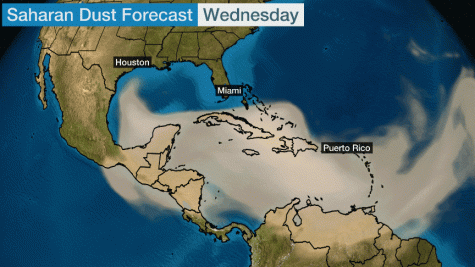A massive plume of dust from the Sahara desert has traveled across the Atlantic Ocean into the Caribbean Sea and is expected to make its way into Mexico and parts of the United States later this week.

Photographers in the Caribbean, Gulf of Mexico and southeast United States should have their cameras pointed to the sky for the next few days. Dust clouds like this one are notorious for providing breathtaking sunrises and sunsets.
You may wonder why this common phenomenon is more newsworthy this time around than in the past.
The thickness of the dust plume over the Caribbean is the highest it has been in a long time. This cloud has the highest concentration of dust particles over the Caribbean Sea in the last 50 to 60 years, according to Dr. Olga Mayol of the Institute for Tropical Ecosystem Studies at the University of Puerto Rico.
Ok, last dust pic for today and this one is perhaps the most incredible yet. The comparison photos were sent to me from Mirco Ferro who lives in St. Barthelemy. Check the dates in the photos (top is from March) – both are unfiltered or altered in any way. #SAL #DUST pic.twitter.com/FBwOG5ly1E
— Mark Sudduth (@hurricanetrack) June 21, 2020
The dust is formed by what experts call the Saharan Air Layer (SAL).
The National Oceanographic and Atmospheric Administration (NOAA) describes the SAL as “a mass of very dry, dusty air that forms over the Sahara desert during the late spring, summer and early fall, and moves over the tropical North Atlantic every three to five days.”
The dry air that carries the dust removes moisture from the air. According to NOAA, the air is about 50% drier than the typical tropical atmosphere. This hampers the formation of tropical cyclones (i.e. hurricanes) in the Atlantic by promoting downdrafts around the storm.
Another effect of the dust plume is an effect known as the African Easterly Jet. Strong winds associated with the SAL can play a part in increasing vertical wind shear – the change of wind speed by height. More wind shear disrupts cyclones’ ability to form.
A large cloud of dust can be a nightmare for those with pre-existing respiratory issues. Throw in a pandemic that is known for shutting down organs (especially, respiratory organs) and it could be a disaster.
Luckily, in the last few months, many people have been wearing masks to help slow down the spread of the coronavirus. Those same masks will now serve a second purpose: relief from the incoming dust.
___
For more information or news tips, or if you see an error in this story or have any compliments or concerns, contact editor@unfspinnaker.com.











